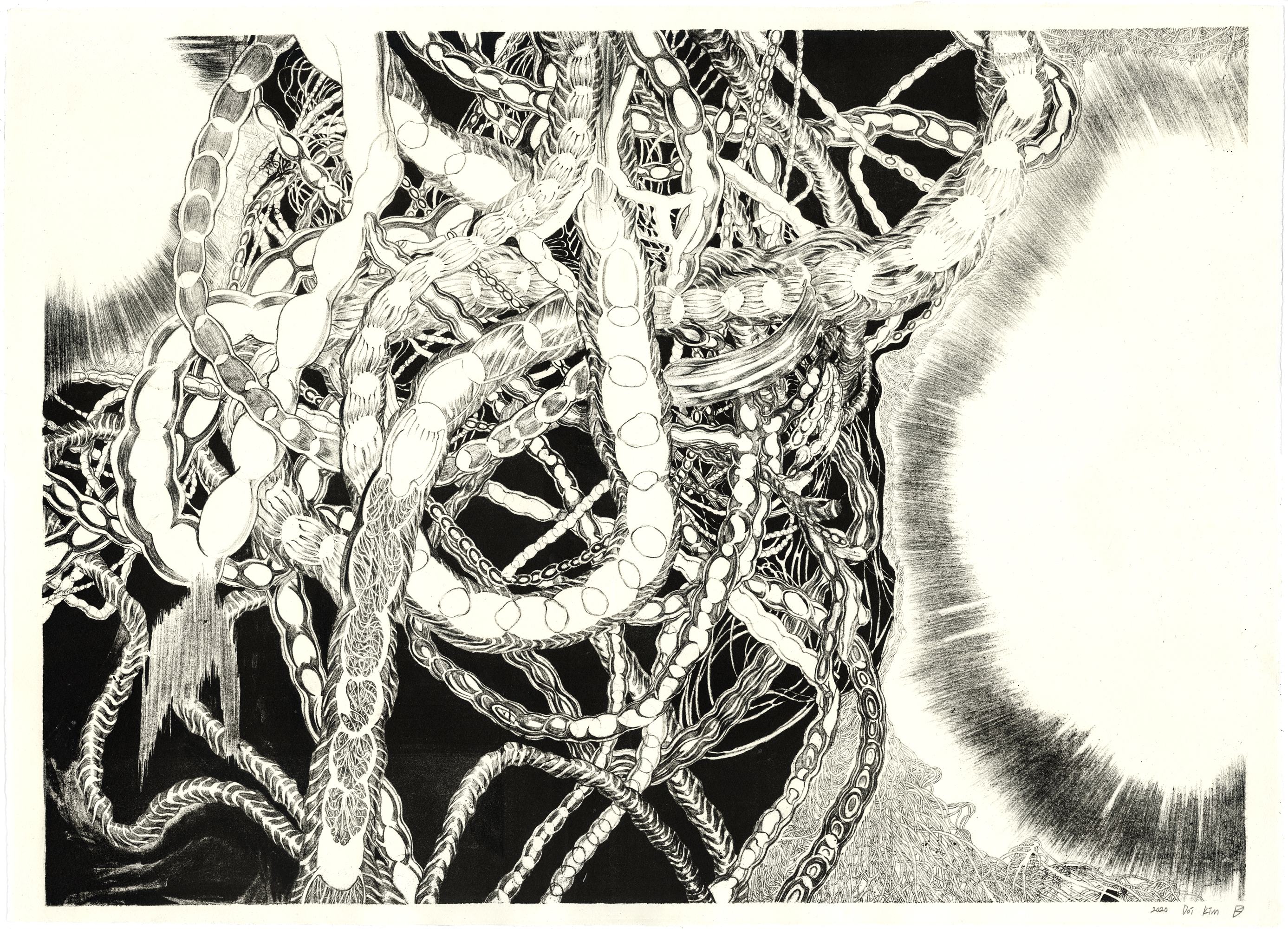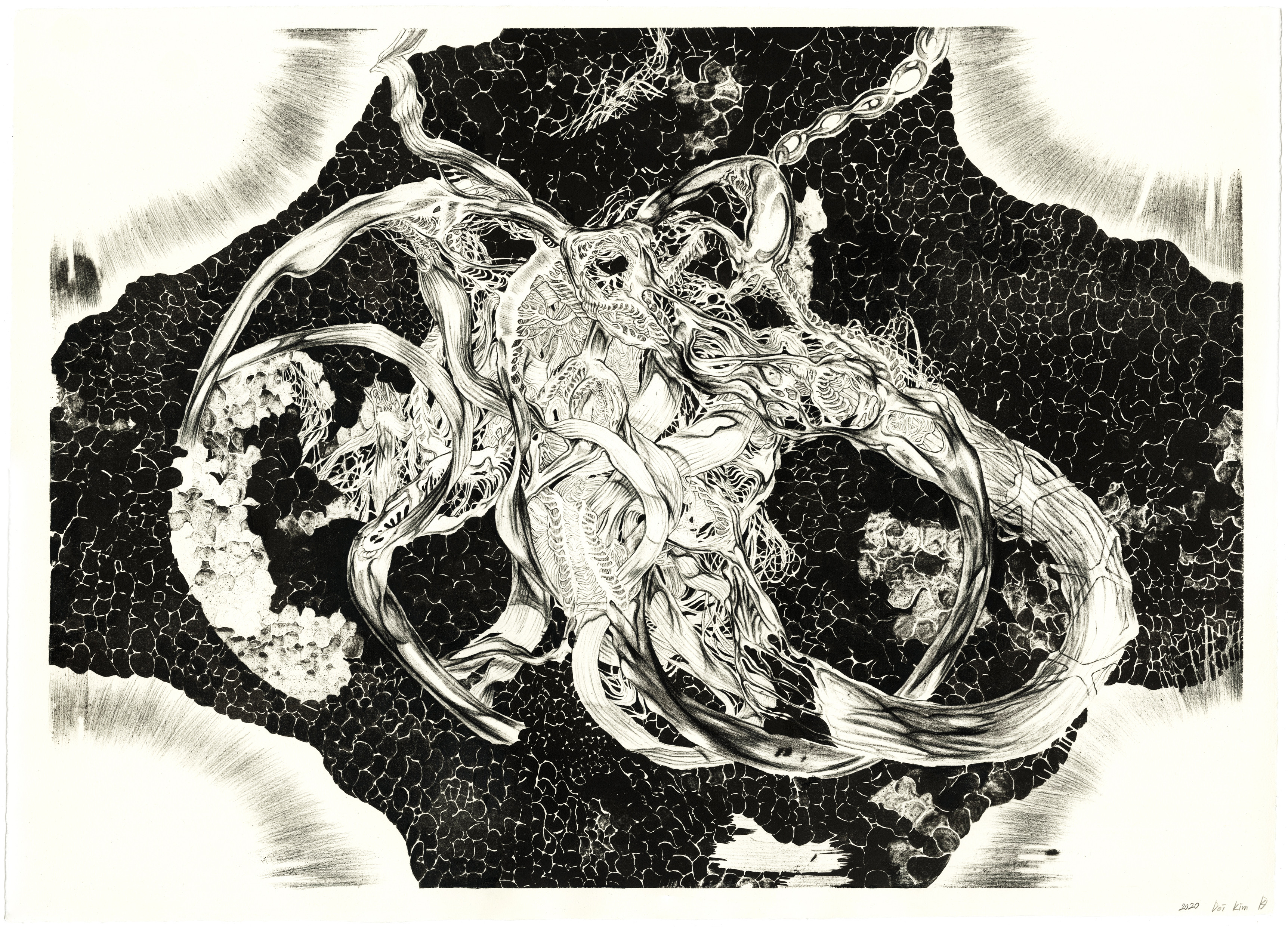The Fifth Child
2020

The Fifth Child explores the ramifications of intergenerational trauma, drawing on epigenetic research and the geopolitical landscape of New York. The project consists of five lithographs depicting a speculative scenario in which a fetus—while forming its umbilical cords, intestines, muscles, and bones—encounters trauma inherited from previous generations.
Each lithograph represents a stage of embryonic development through botanical and anatomical imagery. Lithography links the work’s narrative to its form: the interaction among the lithographic stone (matrix), paper (support), and pressure of the printing press articulates the transfer of inherited experience, while the oily properties of lithographic ink underscore the physicality of the fictional character.
Epigenetics, which examines heritable changes that occur beyond the DNA sequence, suggests that traits shaped by experience can be passed down—aligning with Darwin's theory of evolution. Informed by this idea, The Fifth Child reflects on experiences not directly lived by an individual but transmitted through mental and physical ties. It probes the ramifications of historical and psychological experiences shared within familial or closely knit social groups, inviting viewers to consider how these inherited forces shape the identity and existence of future generations.
The title references Doris Lessing’s 1988 novel The Fifth Child, in which a dysfunctional fifth child, Ben, disrupts his parents’ idealized vision of a perfect family. While the story initially centers on a subversive, mutant figure, it can also be read as an expression of the repressed subconscious and the rigid ideologies shared within a social group. Through this lens, The Fifth Child (2020) raises questions about how deeply embedded social narratives and intergenerational trauma shape individual and collective identities, influencing both the present and what follows.
The Fifth Child는 *후성 유전학 (Epigenetics) 연구에서 단서를 얻어 가족, 혹은 밀접하게 연관된 하나의 사회 집단 안에서 공유되는 정신적, 감정적 경험을 탐구한다. 역사적 트라우마가 수많은 집단 정체성의 근간을 이루는 뉴욕의 사회정치적 상황을 관찰하며 시작된 이 작품은, 혈연 또는 강한 정서적 유대로 연결된 집단과 개인의 관계가 새로운 주체의 형성에 어떤 영향을 미치는지 질문한다.
The Fifth Child는 태아가 자궁에서 자신을 형성하며 각각 탯줄, 내장, 근육, 뼈 등을 형성하는 과정 중에 이전 세대의 트라우마에 노출되는 가상의 풍경을 묘사한 다섯 점의 석판화로 구성되어있다. 이러한 작품의 서사는 석판화 기법을 통해 더욱 견고해진다. 모체(석판), 지지체(종이), 그리고 이미지가 인쇄될 때에 가해지는 압력 사이의 상호 작용은 작품 속의 은유를 구체화하는 중요한 장치로 작동한다. 또한 유성 석판화 잉크의 득특한 질감은 작품 속 가상의 존재에게 육체적인 물질성을 부여한다.
작품의 제목은 도리스 레싱의 소설 『다섯 번째 아이』 (1988)를 차용하였다. 소설에서 예상치 못하게 얻은 다섯째 아이인 벤은 임신 과정에서부터 부모에게 고통을 주고, 결국엔 자신의 부모가 가진 완벽하고 전통적인 정상 가족에 대한 환상을 짓밟는다. 이 이야기는 겉보기에 돌연변이적 존재를 다루는 듯하지만, 정상 가족이라는 강박적인 관념 속에서 억압된 집단 무의식을 은유적으로 드러내며 사회가 공유하는 강박적 이념과 정동을 드러낸다. 이러한 맥락에서 The Fifth Child는 혈연, 또는 깊은 정서적 유대로 연결된 사회 집단 안에서 공유되는 정신적·감정적 경험 또는 개념이 세대 간에 어떻게 전이되고 유전되는지, 그리고 그 영향이 현재와 미래 세대에게 어떻게 작용하는지 사유하며 기억과 정체성에 대한 질문을 던진다.
*후성 유전학이란 DNA 이외의 것들의 유전학을 통칭하며 다윈의 진화론 등에서 제시된 경험으로 획득한 형질이 유전된다는 점이 후성 유전학을 통해 증명되었다. 이러한 후성 유전학 연구의 개념을 바탕으로 시작된 The Fifth Child는 자신이 실제로 경험하지 않았지만, 정신적으로, 또는 혈연을 통해 육체적으로 긴밀하게 연관되어 있는 경험에 대해 사유하기 위한 단서를 제공한다.







© Doi Kim 2020